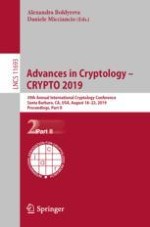2019 | OriginalPaper | Buchkapitel
Match Me if You Can: Matchmaking Encryption and Its Applications
verfasst von : Giuseppe Ateniese, Danilo Francati, David Nuñez, Daniele Venturi
Erschienen in: Advances in Cryptology – CRYPTO 2019
Aktivieren Sie unsere intelligente Suche, um passende Fachinhalte oder Patente zu finden.
Wählen Sie Textabschnitte aus um mit Künstlicher Intelligenz passenden Patente zu finden. powered by
Markieren Sie Textabschnitte, um KI-gestützt weitere passende Inhalte zu finden. powered by


